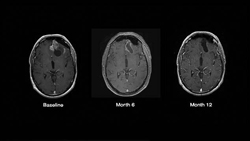Almost everyone has been touched by cancer in some shape or form through its mark on a family member, friend, or loved one. Recently, modern science has armed physicians with a new fourth option for treatment against cancer in addition to surgery, radiation therapy, and chemotherapy, called tumor treating fields therapy (TTF therapy).
When somatic cells divide, they traverse through a specific phase in their life cycle called mitosis, a process policed by myriad regulators. In cancer, certain aberrations arisen from genetic mutations deregulate cell division and cause the parent cell to divide not into just two daughter cells and cease dividing but into two deregulated daughter cells that simply don’t know when to stop dividing.
This leads into a benign tumor which can be remediated by surgery; but if it persists and continues growing uncontrollably, it exacerbates into a malignant neoplasm, otherwise known as cancer. When the malignant neoplasm gains access to the bloodstream, it will metastasize and invade proximal and distal parts of the body, leading collectively to adverse symptoms too many to count.
Tumor cells pass through metaphase, part midway through mitosis in which all of the parent cell’s genetic material is medially aligned prior to splitting into two daughter cells. The polar nature of the proteins forming the spindles holding this apparatus together allows us to view these proteins as a system of dipoles, which are objects with partial positive and negative charges.
At high frequencies, dipoles align with the direction of an electric field and in a converging, non-uniform electric field, the dipoles move toward a region of high field density.
Novocure, a commercial-stage oncology company, has proposed two main mechanisms of using TT fields in mitotic tumor cell division.
In the first, an electric field is irradiated through the dividing cancer cell in metaphase, disrupting the polymerization of the polar tubulin subunits forming the mitotic spindle, stopping the dividing cancer cell in its tracks.
The second mechanism accounts for cells that did complete the formation of the mitotic spindle. As the cells begin dividing, forming the famous “hourglass shape,” an uneven charge distribution pushes all polar cell components toward the neck of the hourglass between the cells leading to structural deformation and cell fragmentation, according to Novocure.com.
Dr. Edward J. Kelsey, physics professor, said “I wonder a bit about why this is new. Electric fields aren’t new and virtually every avenue to treat the disease has been tried.”
Unlike surgery, radiation therapy, and chemotherapy, TTF therapy is tuned to affect only one particular cell type at a time. According to Novocure.com, it is delivered locally through a physical, non-chemical pathway allowing TTF therapy to treat brain tumors whereas “other mitotic inhibitor treatments such as taxanes and vinca alkaloids have poor diffusion across the blood-brain barrier and are rarely used to treat brain tumors.” Because the TT fields alternate so rapidly, they actually have no effect on normal cells or do they stimulate nerves and muscles.
“Targeting the mechanism of division in cancer cells with the use of a tumor-treating field is a fascinating approach in the field of medicine that can save many lives. In my opinion, more assurance is needed regarding the effect of these fields on normal cells,” said Wardha Qureshi, sophomore biology major.
Bill Doyle, Executive Chairman of Novocure, showcased the results of the clinical trials of TTF therapy at a TEDMED Talk posted in January 2012. One of the patients from the trial was Robert Dill-Bundi, a famous Swiss cycling champion who won the gold medal in Moscow in 1980 in the 4,000 meter pursuit.
Six years ago, Bundi was diagnosed with the most aggressive primary malignant brain tumor in humans, known as glioblastoma multiforme (GBM). Bundi had received surgery, a high-dose of radiation therapy to the head, and chemotherapy. After a year of treatment, however, his tumor had grown back and Bundi was told that he had three months to live. He then joined the clinical trial.
Noninvasive electrodes that deliver low-intensity electric fields were applied like bandages to Bundi’s head. “Patients can undergo all the activities of their daily life. There is no tiredness [nor any] sensation. It doesn’t interfere with computers or electrical equipment [and] the therapy is delivered continuously at home, without having to go the hospital either periodically or continually,” said Doyle at the TEDMED Talk.
After six months of treatment, Bundi’s tumor had responded and begun to melt away. After one year, it was “essentially completely gone.” Today, six years after Robert Dill-Bundi’s diagnosis, “He’s alive, but more importantly, he’s healthy and he’s at work,” said Doyle.
In an interview with Doyle, Robert Dill-Bundi said he rates his quality of life a bit different from what most people would assume. “I am the happiest, the happiest person in the world. And every single morning I appreciate life. Every night I fall asleep very well, and I am, I repeat, the happiest man in the world, and I’m thankful that I’m alive.”
Genevieve Fasano, sophomore biology major, feels that “The idea of using electric fields to treat cancer initially sounds pretty scary. However, the benefits easily will win patients over since using tumor treating fields helps a patient avoid the ugly side effects of chemotherapy. Also, being able to deliver cancer therapy at home, as demonstrated by the patient with GBM is a huge plus, and really shows the progress modern medicine has made to combat cancer.”
As urbanization emerged in the nineteenth century, flat buildings transformed into monolithic towers, reaching to the skies. As we expand our base of research in science from the fundamentals to the interconnected unity between them, we will progress in a new direction and as one community bound by researchers, physicians, family members, and friends, we will give cancer a taste of its own medicine.
PHOTO COURTESY of novocure.com




